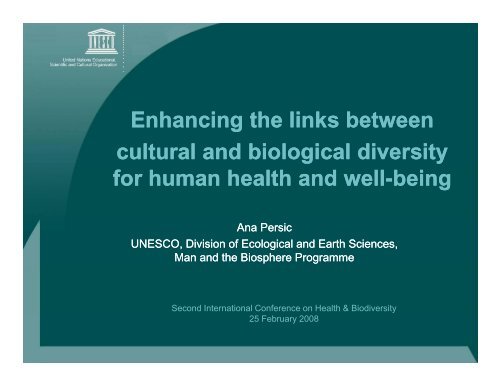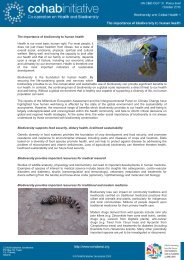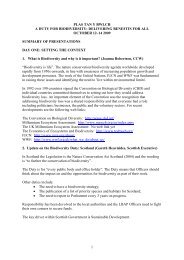Ana Persic - COHAB Initiative
Ana Persic - COHAB Initiative
Ana Persic - COHAB Initiative
You also want an ePaper? Increase the reach of your titles
YUMPU automatically turns print PDFs into web optimized ePapers that Google loves.
Enhancing the links between<br />
cultural and biological diversity<br />
for human health and well-being<br />
<strong>Ana</strong> <strong>Persic</strong><br />
UNESCO, Division of Ecological and Earth Sciences,<br />
Man and the Biosphere Programme<br />
Second International Conference on Health & Biodiversity<br />
25 February 2008
Diversity of Life<br />
Biological diversity -diversity<br />
within species, between species, and<br />
of ecosystems<br />
cultural practices depend<br />
upon specific elements of<br />
biodiversity for their<br />
existence and expression<br />
ensembles of biodiversity<br />
are developed, maintained<br />
and managed by cultural<br />
groups<br />
Cultural diversity - diversity of<br />
practices, ways of living together, value<br />
systems, languages, g artistic<br />
expressions – means to achieve<br />
emotional, moral, spiritual existence
Biological - Cultural Diversity<br />
Language and linguistic diversity (terms, concepts)<br />
Material culture (objects created from bd, reflecting<br />
spiritual and religious beliefs)<br />
Knowledge and technology<br />
Technology and techniques (practice using natural<br />
materials)<br />
Traditional and local knowledge<br />
Transmission of knowledge and skills<br />
Modes of subsistence<br />
Natural resource use and management<br />
Plant/animal domestication and selective breeding<br />
(e.g. creation and maintenance of genetic<br />
diversity)<br />
Economic relations (partnerships based on trading natural resources, going beyond eco borders)<br />
Social relations (e.g. social roles relating to differential resource use)<br />
Attachment to place (e.g. cultural identity inscribed in natural places)<br />
Gender (e.g. gender specific environmental knowledge)<br />
Political relations (e.g. control over differential resource access)<br />
Legal institutions (e.g. customary law governing resource/land access)<br />
Belief systems<br />
Rites and rituals (e.g. those celebrating seasonal events)<br />
Sacred sites (e.g. the conservation of sacred forests)<br />
Mythology, worldview, cosmology and spirituality<br />
Constructing identity with/through the natural world (e.g. totemism, nagualism, tonalism)
Loss of Diversity<br />
Diversity is being lost at<br />
unprecedented rates<br />
Reduced diversity makes the<br />
world increasingly vulnerable to<br />
change posing a threat to global<br />
stability<br />
Cultural diversity together with maintenance of biodiversity is essential<br />
to the quality of life and human well-being.<br />
Diversity loss needs to be dealt with in holistic, more comprehensive<br />
ways that t recognize the links between components of diversity it and<br />
address them together.
Diversity in UNESCO<br />
UNESCO - unique position to mainstream<br />
the links between biological and cultural<br />
diversity in research, political dialogue<br />
and action<br />
UNESCO/UNEP - High Level Round Table<br />
on ‘Cultural Diversity for Sustainable<br />
Development” World Summit on<br />
Sustainable<br />
Development,<br />
Johannesburg, 2002.<br />
The objective: to underline the importance of<br />
respecting and integrating the diversity of<br />
nature and culture as a prerequisite for<br />
sustainable development.<br />
The main recommendation was to add<br />
cultural diversity as the forth pillar to<br />
achieve sustainable development
Diversity in UNESCO<br />
Since 2002 - “Enhancing the linkages between biodiversity<br />
and cultural diversity as a key basis for sustainable<br />
development“<br />
<br />
A number of activities have been developed and<br />
implemented:<br />
• local, traditional and indigenous<br />
knowledge (LINKS, MAB);<br />
• languages (indicators IBCD, CBD);<br />
• tangible and intangible heritage;<br />
• sustainable management of<br />
natural resources<br />
Main goal - to enhance the linkages between biological and<br />
cultural diversity and use them to promote environmental and<br />
human well-being from international to site specific levels.
UNESCO sites and Diversity<br />
World Heritage Sites<br />
conservation of cultural, natural and<br />
mixed sites (cultural landscapes) of<br />
outstanding universal value<br />
Biosphere reserves<br />
testing approaches to sustainable<br />
development based on science and<br />
local community efforts
Addressing biological and cultural<br />
diversity it in tandem – examples form in<br />
Biosphere Reserve<br />
MAB Programme - Intergovernmental programme aiming at laying<br />
scientific basis for the improvement of people - environment<br />
relationships.<br />
Biosphere reserve concept designed as field tool for<br />
interdisciplinary MAB work<br />
‣ Conserve natural and cultural diversity<br />
‣ Models of land management and of<br />
approaches to sustainable development<br />
‣ Research, monitoring, education and<br />
training<br />
i
Knowledge and technology<br />
Uluru-Kata Tjuta Biosphere Reserve, Australia<br />
Aboriginal traditional practices of landscape<br />
management, including burning, are included d in the<br />
management plan of the site.<br />
The fire-management regime integrates aspects of<br />
traditional burning practices with a scientifically<br />
based approach to:<br />
- maintain the site’s biodiversity<br />
- protect life, property and culturally<br />
significant sites and mitigate the effects of<br />
wildfire<br />
Traditional practices coupled with scientific<br />
knowledge provide innovative tools that sustain<br />
both biological and cultural diversity.
Linguistic diversity<br />
Bosawas Biosphere Reserve, Nicaragua<br />
The indigenous Mayangna are knowledgeable about<br />
human-nature nature interactions, and put into practice<br />
lifestyles that conserve biological diversity.<br />
LINKS Programme documents this knowledge in a<br />
bilingual pedagogical tool:<br />
- to transfer Mayangna knowledge and know-how<br />
on the aquatic system, freshwater fishes & turtles.<br />
- to serve as a dialogue base between managers,<br />
scientists & traditional knowledge holders<br />
By maintaining their language and the vitality of<br />
indigenous knowledge, the Mayangna can<br />
continue informing the development of<br />
culturally-appropriate ll t and sustainable<br />
biodiversity management options.
Traditional belief systems<br />
Xishuangbanna Biosphere Reserve, China<br />
Traditional belief in sacred forests has made a great<br />
contribution to biodiversity conservation.<br />
Holly hills set aside by the Dai people and other ethnic<br />
groups as ‘sacred forests’ have preserved islands of<br />
forest biodiversity in mountain and hilly areas.<br />
Protection of forests guarantees water supply, and<br />
provision of animal and plant products to support daily<br />
life and nutrient balance of the local communities.<br />
Conservation of biodiversity based on cultural and<br />
religious values - more sustainable than that based<br />
only on government legislation l or regulation.
Material culture<br />
Al Shouf Biosphere Reserve, Lebanon<br />
Local communities interaction with natural<br />
resources: exploitation of wood & non wood forest<br />
products, food processing, handicrafts, etc.<br />
Mutual influences constitute t the key element for an<br />
integrated management plan aiming at:<br />
- maintaining sustainable practices,<br />
- ensuring biodiversity conservation &<br />
sustainable development<br />
- providing locals with appropriate job<br />
opportunities<br />
The patrimony and traditions of the rural society<br />
is enhanced through the sustainable use of<br />
biodiversity.
Challenges for the future<br />
- to integrate lessons learned from BR<br />
experience on biodiversity - cultural diversity<br />
linkages in management and policy<br />
decisions dealing with sustainable<br />
development, poverty alleviation, health and<br />
well-being,<br />
- to translate the principles of mutual<br />
reinforcement of cultural and biological<br />
diversity at the site-specific level into<br />
proposals for policies and action on the local,<br />
regional and international levels.
Towards tools for policy and action<br />
Progress in raising awareness about the importance of the<br />
links between biological and cultural diversity and the<br />
dangers of addressing them separately.<br />
Academia - ethnoecology, historical ecology, deep ecology…<br />
IGO and fora - UNESCO, UNEP, United Nations Permanent<br />
Forum on Indigenous Issues, International ti Indigenous Forum on<br />
Biodiversity, Tebtebba, Inuit Circumpolar Conference…<br />
NGOs - IUCN, Terralingua, Resilience Alliance, Global Diversity<br />
Foundation…<br />
Intergovernmental processes and policy instruments - explicit<br />
reference to cultural drivers when dealing with biological diversity and<br />
vice versa.<br />
Convention on Biological Diversity<br />
Ramsar Convention on Wetlands<br />
World Heritage Convention<br />
Millennium Ecosystem Assessment
Towards tools for policy and action<br />
The increase in development<br />
and application of<br />
approaches linking biological<br />
and cultural l diversity it raises<br />
the need to clarify key<br />
theoretical and<br />
methodological issues to<br />
ensure a more systematic<br />
ti<br />
consideration of such<br />
approaches and their use as<br />
meaningful tools for policy<br />
and practice.
Links between Biological & Cultural Diversity<br />
Concepts, Methods & Experiences<br />
International workshop organized by UNESCO<br />
with support of The Christensen Fund, September 2007
Main objectives<br />
<br />
<br />
Elucidate the main concepts related to<br />
biological and cultural diversity that should<br />
be taken into account when addressing<br />
diversity in an integrated manner;<br />
Develop recommendations for:<br />
• a conceptual framework for assessing<br />
the linkages between cultural and<br />
biological diversity<br />
• future integrated research at the<br />
biological-cultural diversity interface<br />
• policy and action
Concepts<br />
Main results<br />
• Common conceptual framework – to be developed on the already<br />
existing reflections (bio-cultural theory, resilience, cultural landscapes…)<br />
and linked with on-the-ground research & practice<br />
• Common methodological framework - to be developed based on<br />
holistic, interdisciplinary, multi-scale, participatory & collaborative<br />
research approaches.<br />
Research<br />
• Principal units and appropriate scale for diversity research<br />
• Dynamics of knowledge<br />
• Processes that reduce, modify and/or produce diversity through<br />
the ‘homogenization - hybridity – diversification’ process<br />
• Impact of demographic shifts and dynamics on diversity<br />
• Development of a value-based system for diversity<br />
Theoretical and conceptual research need to be coupled with on ground<br />
research in collaboration with all the relevant stakeholders, starting with the<br />
local population.
Policy<br />
Main results<br />
At the international level<br />
• Integrate cultural diversity in MEA<br />
• Integrate considerations on biological diversity in<br />
international treaties dealing with cultural diversity<br />
At the regional level<br />
• Include the links between biological and cultural diversity in resource<br />
management and valorization of cultural & natural heritage;<br />
• Revise nature classification schemes and monitoring tools<br />
At the national level<br />
• Identify cultural values in territories, define their significance,<br />
integrity & vulnerability<br />
• Manage the process of data collections and collation<br />
• Monitor and manage the process of transformation<br />
• Ensure research development to gather evidence
For the Future…<br />
UNESCO intends to play an active role with regard to<br />
the further study and the promotion of the relationships<br />
between biological and cultural diversity and their links<br />
to other agendas<br />
Priority will be given to developing systematic<br />
approaches to study these relationships<br />
Attention will be paid to distilling principles of biologicalcultural<br />
diversity interactions that may assist with the<br />
design and implementation of relevant policies.
For the Future…<br />
<strong>Ana</strong>lytical and scientific work conducted by UNESCO in<br />
this area is hoped assist with normative work related to<br />
biological and cultural diversity and other cross-cutting<br />
issues<br />
Reinforcing and building bridges between:<br />
• The Convention for the Safeguarding of the Intangible Cultural<br />
Heritage,<br />
• The Convention on the Protection and Promotion of Diversity of<br />
Cultural Expressions,<br />
• The World Heritage Convention,<br />
• The Convention on Biological Diversity,<br />
• The Ramsar Convention on Wetlands and other biodiversityrelated<br />
conventions,<br />
• Cross-cutting interdisciplinary initiatives - <strong>COHAB</strong><br />
Ultimate goal is to integrate diversity as a key<br />
component of environment, development, health and<br />
poverty reduction agendas to effectively contribute to<br />
enhancement of human well-being and the achievement<br />
of the MDG across the world
Thank you for your attention!




